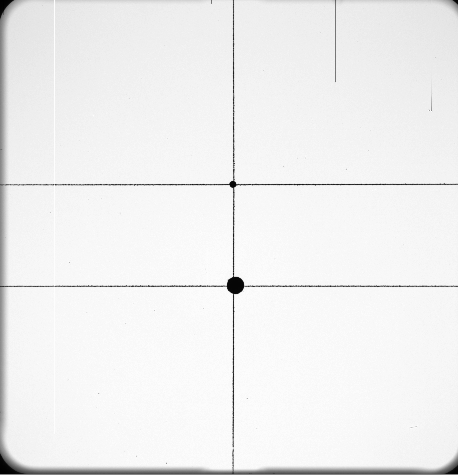EFOSC2 Star-plate Set
Table of Content
- Wollaston Masks are described on the polarimetric elements page.
- Flexure problems since moving to NTT.
The terms Star-plates, slits and masks are used interchangeably - they all refer to elements which block light from some region of the field of view of EFOSC2. All these are mounted on the Aperture wheel of EFOSC2.
The aperture wheel is located on the focal plane of the telescope - it is the only optical element in the instrument located before the collimator. The scale at the aperture wheel is the same as the telescope scale (= 5.36 arcsec/mm).
The Slit wheel contains 10 positions of which
- 1 position should always be kept free
- 1 position is permanently occupied by the moveable 1.5" slit
- 1 position is needed for the pinhole mask for aligning other optical elements (grisms)
- 1 position should be reserved for the 5" slit which is needed for spectrophotometric calibration.
- 1 position is occupied by the Holes Mask used for focussing the instrument during the set-up night.
Thus between 5 and 7 positions are available for user selected elements at any given time. The full list of star-plates is given below.
Spectroscopic Long slits
The following spectroscopic long slits are available for use on the EFOSC2 instruments :
The length of the slits is 4.1 arcmin.
The 1.5" moveable slit
The moveable 1.5" slit is permanently mounted on the EFOSC2 instrument. It can be displaced by 10 mm on either side of the centre position by means of a screw. A scale with 0.5 mm markings is located under the slit for measuring the displacement. Moving the screw clockwise shifts the spectral lines towards the blue, i.e. the spectral coverage shifts towards the red. The change in spectral coverage is given by
dL = 45.5 D * dY
where,
dL is the shift in wavelength in Angstroms,
D is the dispersion of the grism in Angstrom/pix and
dY is the displacement of the slit in mm
However, one should always check the shift by taking a He-Ar spectrum (request the support astronomer to obtain this directly from the OS panel) and visually determining the wavelength range.
The y-pixel location of a slit varies from one installation to another by a few pixels. Observers should obtain all the required calibrations before a slit is dismounted from the wheel.
Offset slits
During the commissioning of the VPH Grisms it was realised that using slits with a fixed offset could be used to extend the wavelength covered by the blue VPHG (Gr#19) to cover interesting features beyond the normal range. There are now offset slits available (with the same selection of widths as the standard slits) for this purpose with 15mm offsets (corresponding to wavelength offsets of 218 Å for Gr#19) are now available, so the wavelength range for Gr#19 is now 4180 Å to 5320 Å (the full range is achievable by combining red offset and blue offset spectra). These slits can of course be used with any other grism; the wavelength shift can be found using the above formula with dY = 15mm.
MOS Slit Masks
These are user defined and punched plates for multi-object spectroscopy. EFOSC2 recognises 5 MOS names - Mos#1, Mos#2, Mos#3, Mos#4 and Mos#5 though jP2PP recognises 3 more MOS names. More information on MOS mask creation can be found in the Multi-Object Spectroscopy page.
Coronographic Mask
There is coronographic mask available. It is called by the name Cor_mask in the jP2PP templates. The sizes for the large and small spots for the mask are 8.0 and 4.0 arcsec respectively.
Coronographic Mask

Additionally, there is another mask, the Lyot stop which has to be used in coronographic observations to eliminate scattered light from bright stars. This however is mounted on the grism wheel even though it is a mask (since it must be mounted in the pupil plane of the instrument). The Lyot stop has to be carefully aligned using a very bright star. This alignment procedure requires an hour or two to execute.
Flexure problems
EFOSC2 was originally designed to be mounted in Cassegrain focus. The aperture wheel (as all other wheels) were moving in a horizontal plane inclining only with the telescope. Since EFOSC was moved to the Nasmyth focus at NTT, we experience flexure problems due to the fact that the instrument is now turned on the side and gravity can influence the position of the slits depending on the rotator position of the instrument. The effect of the flexure is a variation of the central Y-position of the slits of about 1 pixel. This results in shifts of the wavelength solution but also in the possibility that the object is not centered perfectly in the slit anymore. Occasionally, also larger shifts (up to 3 pixels) have been observed.
To account for the shift in wavelength, we recommend to either use sky lines in the spectra to correct for these shifts or take regular HeAr measurements during the night. To account for the possibility that the object might not be centred, we have developed a new aquisition template EFOSC_img_acq_NarrowSlit which takes first an image of the slit and allows to measure its central Y-position before doing the actual acquisition. We recommend to use this template for spectroscopic observations using slits more narrow than 1.5".
